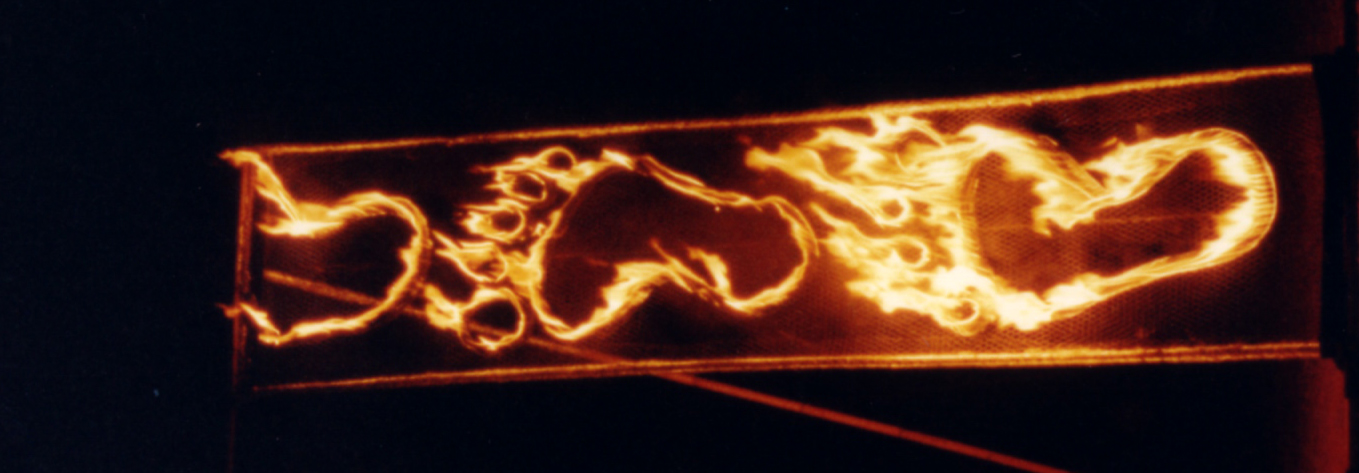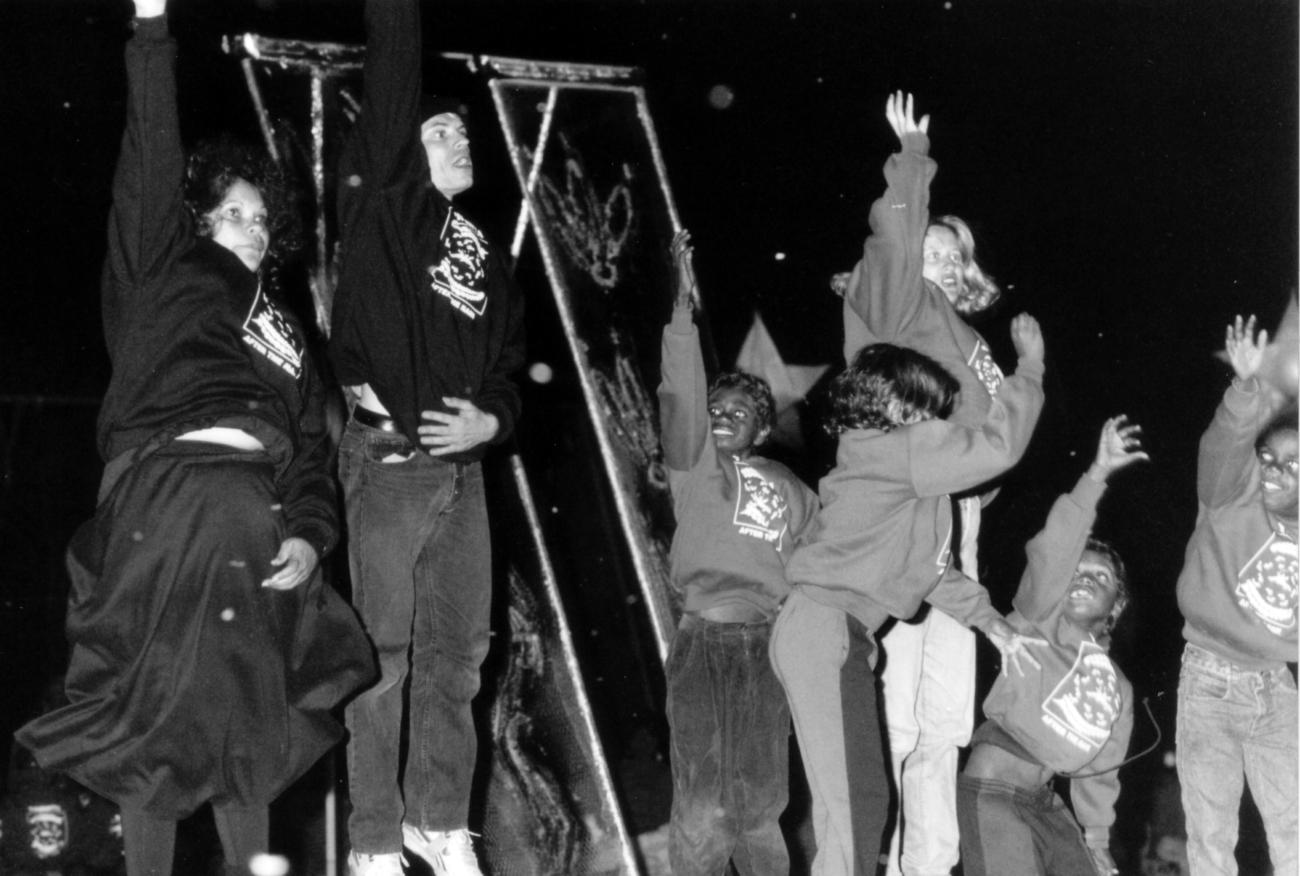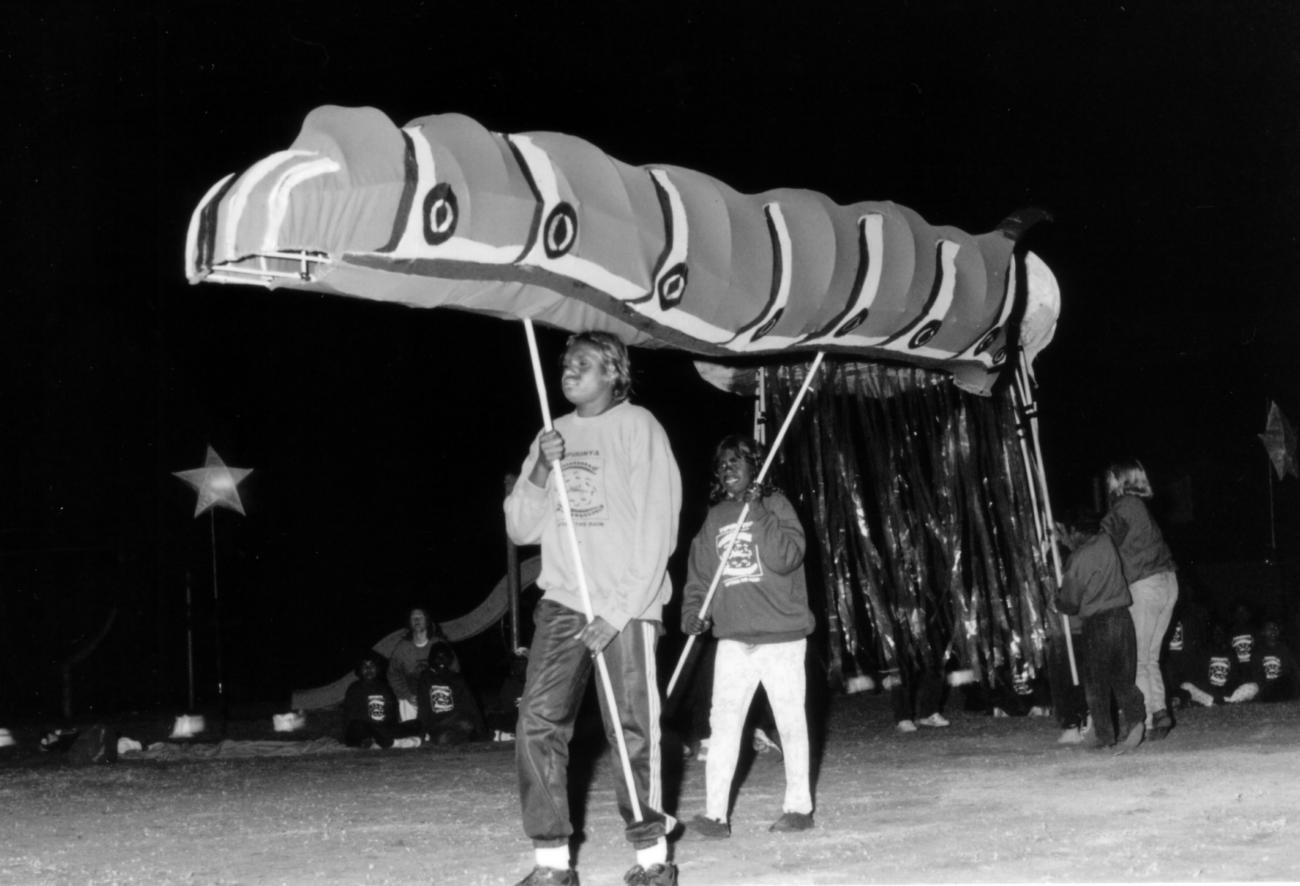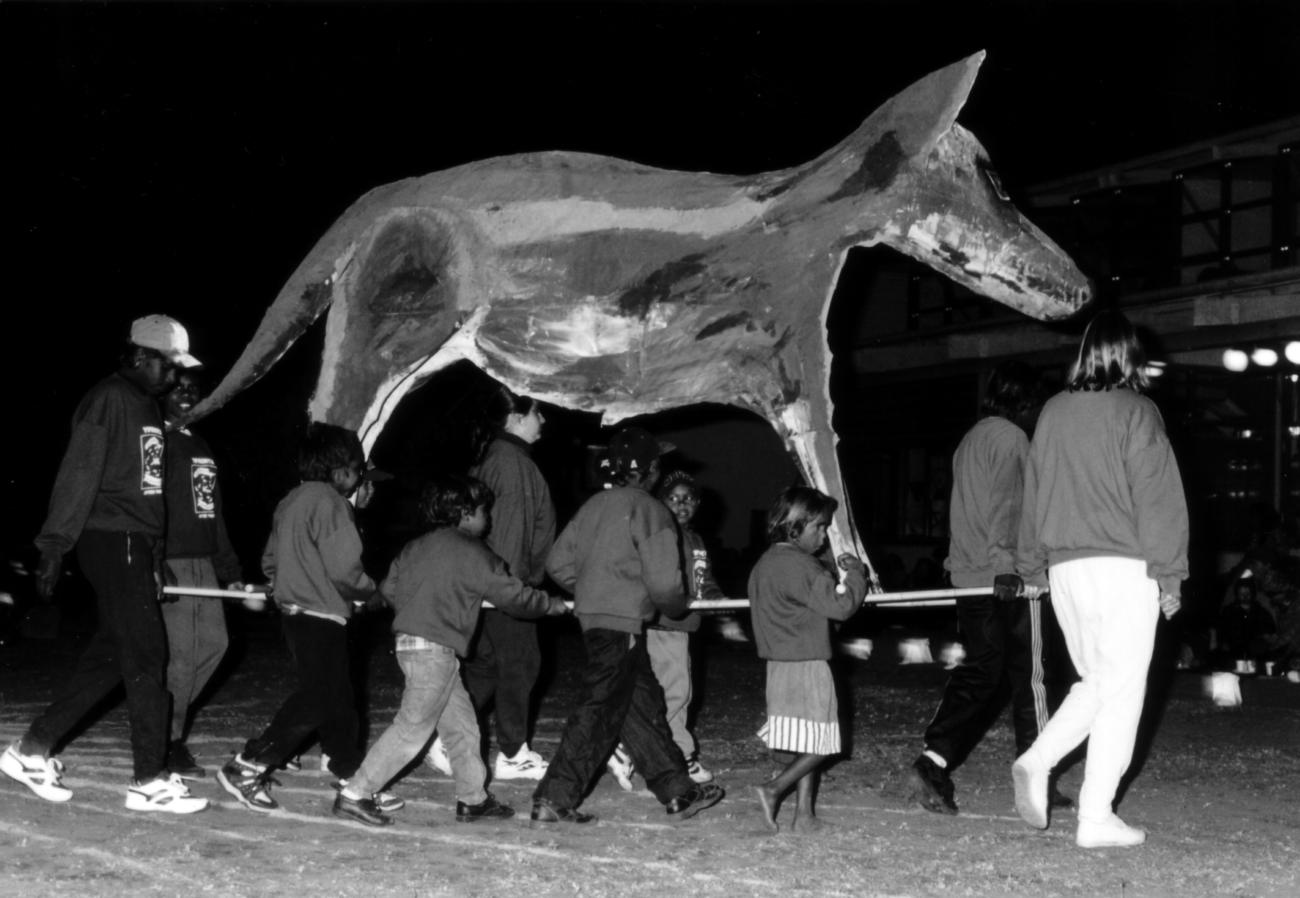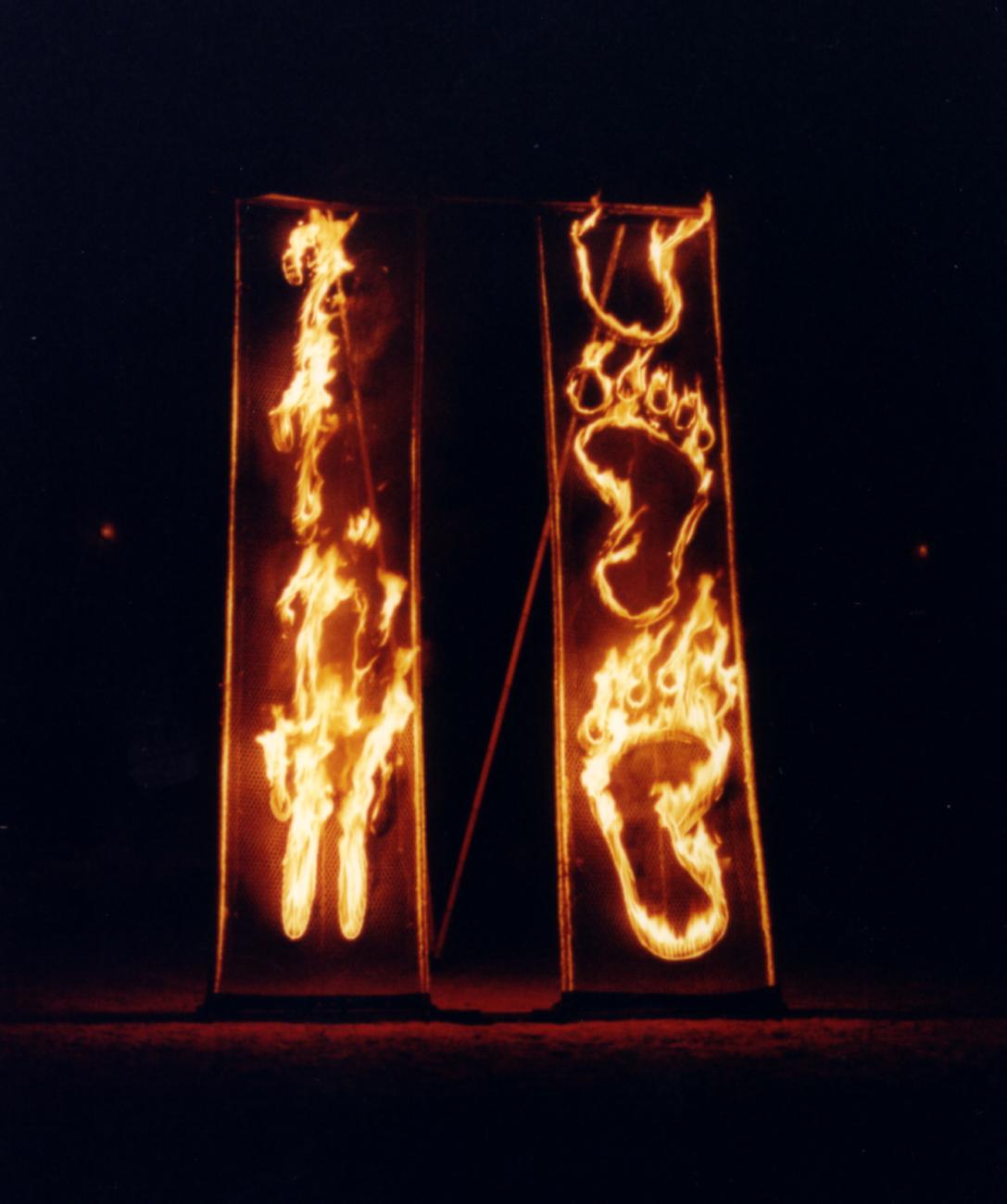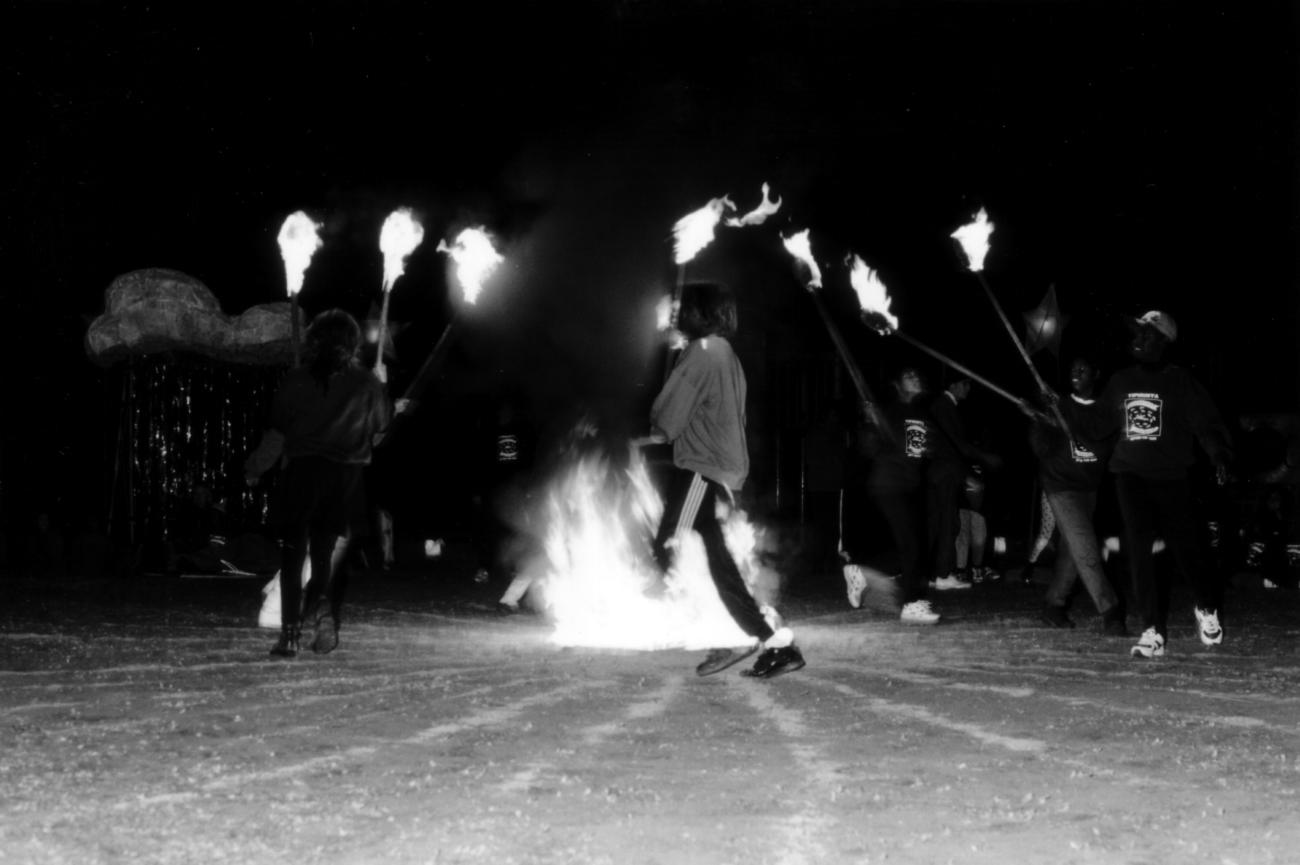After the Rain - Yipirinya, Alice Springs Residency
Text
Yipirinya School Grounds, Alice Springs
June 22, 1995
Based at Yipirinya School this project was a result of previous residencies attached to the Lajamanu touring projects in the late 1980’s, and Yipirinya Kids Perform From Little Things Big Things Grow 1992. The school was looking for a creative way to “come together”, a difficult task when there were five different languages: Central Arrernte, Western Arrernte, Luritja, Warlpiri, English, as well as many social problems attached to people living in remote places and in town camps.
Yipirinya School was founded as an Independent Aboriginal Community School through the initiative of Indigenous members of the local community in 1978. It is controlled by an Indigenous Council and caters for Indigenous students from Alice Springs town camps and nearby outstations. It is the true School of Alice Springs, going back to the beginning, to the Caterpillar Dreamtime.
Yipirinya School has classes from pre-school to lower secondary. The School offers a two-way (bi-lingual & bi-cultural) approach to education. Vernacular teachers offer additional support when children have vernacular language classes each day.
Notes
Yipirinya After The Rain worked with the existing school structures and syllabus to create a unifying program. The Artistic Staff liaised with the school staff and the community elders, as well as other education centres where students had moved.
The creative team consisted of Tim Newth - Director and Designer, David McMicken - Co-Director and Choreographer, Dorethea Randall – Indigenous Choreographer, and Mahoney Kiely – local theatre worker and image-maker. This team allowed for a great deal of flexibility, a necessary thing when working in the context we found ourselves in.
The work exists on many levels because of the nature of the community in which we were working. Due to the many layers of meaning in the overall work, the approaches and methods employed to implement the performance material through the different language groups and cultures was quite varied: story telling, dance, mime, drama, visuals, music.
It is nearly impossible to change the dance very much once it is created as the younger people expect it to be done “proper way” and constant changes only confuse them. Also, the attendance of the students was in no way guaranteed and there was always a chance that they may only attend one or two sessions in total. The choreography had to take into consideration several factors:
- The students follow an older person rather than lead.
- A “mob” way of thinking is at play where no-one is the single boss. These students generally work as a group, or “mob”. Singling out individuals can be very detrimental to the overall process.
- These students are experts at making their own choices as to how much they will participate. It is always a possibility that they might refuse to do something, or everything.
- Certain movements cannot be done due to cultural constraints
- Certain sounds cannot be used
- Mixing of the sexes is almost impossible
- Many of the students do not have a good grasp of English and I have no grasp of their language except for minimal Warlpiri. Therefore the way instructions are given has to be taken into consideration.
- Many students have hearing problems and do not hear instructions clearly. Movement needs to be clear and simple.
- The dances had to be based both on the class work each different group was studying as well as fit into an overall story that we had been told by two elders.
A great source of information came from Trudy and Davey Inkamala who early in the process told us stories about the Yeperenye Caterpillar, the Emu and Dog dreamings.
An important aspect of this project was the training of Tim Thomas. He is a Central Arrernte man currently studying to be a teacher through the Anangu Tertiary Education Program. He was stationed in the Central Arrernte classroom. Tim had previously created dances for the school, including a caterpillar dance, which was performed all over Alice Springs. He was extremely interested in the arts as a medium for teaching and asked if he could work with us. We arranged for him to be released from some of his class work so that he could observe, participate and teach with us. We gave him the express task of creating a dance for the Central Arrernte class, which was based on “emus” as they were studying them in their class.
Tim was very eager to assist. He had many ideas and was very good at putting them forward. It was also helpful for Dorethea to have another Aboriginal Dancer on the team. Tim discovered that he could get information from the class, that he did not need to create it all himself. He also discovered other methods of putting material together. The students instantly responded to his teaching. It was a great shame that due to personal reasons, Tim had to go to Mildura and was not able to see the process through to the performance.
The importance of multi skilled artists when working on these projects cannot be stressed enough. The team was well represented on a wide range of arts activities: Tim Newth; Visual, Directorial skills, puppetry and Dance. Mahoney Kiely; Dance, gymnastics, acrobatics, puppetry, fire. David McMicken; Dance, drama, music, making, administration, teaching. Dorethea; dance.
Conclusion
This project was a development from the previous show. Although the older students were no longer present in the school and this hindered the expected development, other aspects were just as exciting. There was a far greater input from the Aboriginal staff than last time. This gave a feeling that the school community had far more control over the project than last time. We were instructed in the very beginning regarding some basic content. We were told stories from a traditional base which had not happened before. We were given permission to use some traditional dance in the show. There was an Aboriginal teacher solely teaching the pre-school and she was one of the finest teachers I have come across. The Aboriginal teachers in the Central Arrernte class, (Beverly and Timothy,) were having a great influence on the students. Esther in the senior class ended up performing with the students and leading a “Star Dance” which freed me up for that dance. We were able to work with previous Yipirinya students who are now at the Catholic College. As older youths they were able to take on an intricate Fire Dance as well as take on other responsibilities at short notice. It allowed the other students to see another aspect of their school community, to see that it extended past the time they leave. It was also a chance for older sisters to be seen in positions of responsibility and excitement.
There is so much potential for development in this unusual community. Though it was three years in between projects and many of the students had moved on, we were able to make some major advances in this project. Prior knowledge of the working processes in the school was a major assistance and also a greater understanding in general of Aboriginal culture.
Successes:
- More Aboriginal input into content
- Traditional information and stories handed over, showing trust in the artistic team.
- Stronger input into the major making tasks.
- Wider use of arts activities used, (more art work, story telling, drama)
- Extension into wider community bringing older ex-students back.
- More support from Aboriginal organisations, (Central Australian Aboriginal Music Association, Impaja TV)
- Skill development and training for specific arts people in the school community (Tim Thomas and Lenny).
- Easier administration
- The wider school community, (cleaners, maintenance, grounds person, security, administration, language centre, ANTEP programme, sports teachers etc.) swung into action with more clarity.
Creative Personnel
Director Designer: Tim Newth
Co-director Choreographer: David McMicken
Choreographer: Dorethea Randall
Designer and maker: Mahony Maia Kiely
Trainee Teacher (Central Arrernte): Tim Thomas
Performers
The students of Yipirinya School
Scenario
- Procession - Everyone enters into the space behind the Caterpillar puppets. Elders Feed the caterpillars who then go and sit around space watching the proceedings.
- Fire Dance - Secondary students now at the Catholic College present a fire dance using fire batons.
- Star Dance - Senior Students a simple manipulation of star lanterns on 10-foot poles. The students needed to work on spatial relationships in order to maintain the shape of the work.
- Orbit Dance - Senior Students dance about the universe and orbiting. Circuit: somersaults, cartwheels, spins and jump spins.
- Rock Wall, The Gap - The senior class create a wall of rock, representing an Alice Spring landmark, The Gap, a significant sacred site. It also represented Emily Gap which is a place the Yipirinya Caterpillars came from. The senior class had to remain still for the duration of the Child Care’s dance and then allow themselves to be crawled over by the Pre-school students.
- Eggs To Anything- Preschoolers carry large eggs and climb over the wall and then dance about transformation. From egg to grub to beetle. From egg to mudeye to dragonfly. From egg to tadpole to frog. From egg to maggot to fly.
- Follow The Leader - Childcare follow the leader, with wings
- Outer Space - Seniors return with more acrobatic and balance work
- Rain, Lightning- Luritja group creates a storm and growth.
- Following Tracks, Hunting - Warlpiri bring in fire sculptures of tracks and light them. The four images are: Yapa Wirlya - Person (Aboriginal), Yankirri - Emu, Marlu - Kangaroo, Warna – Snake.
- The hunting dance involved a repetitious set of practical functions; setting up the humpy Ngurra, looking for tracks of Emu, (low), Bird (High) and Kangaroo (distant). Return to the humpy, go out and find a snake track around the humpy, return to humpy, leave humpy and form circle for the snake dance. The snake dance was a circle dance, involving snake like movements of the hands, (slithering and fang biting) getting out of the skin and being all new and shiny, jumping in and out of the skin and then eating, (mouse and rabbit). We finished the snake dance making several different group snakes, standing and sitting. They end up making the nest that the Emu is in looking after his eggs
- Emu - Central Arrernte bring in large emu to sit on the nest of eggs. They dance about the emu and the way the father bird looks after the chicks and looks around for water.
- Dog - Western Arrernte group bring in a large Dingo and perform the ‘puppy dog” dance using moves from traditional dog dance. They also dance about the dog prowling at night and looking for snakes.
- Transition, Dog/Emu - Everyone joins in as the emu and dog circle each other
- Using moves from emu and dog to clear the space
- Contemporary - The Boys and girls head into a high energy contemporary dance
- Finale - Caterpillars go “underground – Finish!”
Tracks Dance Collective 1995
Co-Artistic Directors: Sarah Calver, David McMicken, Tim Newth
[Under Brown's Mart Community Arts – Executive Officer Ken Conway]

